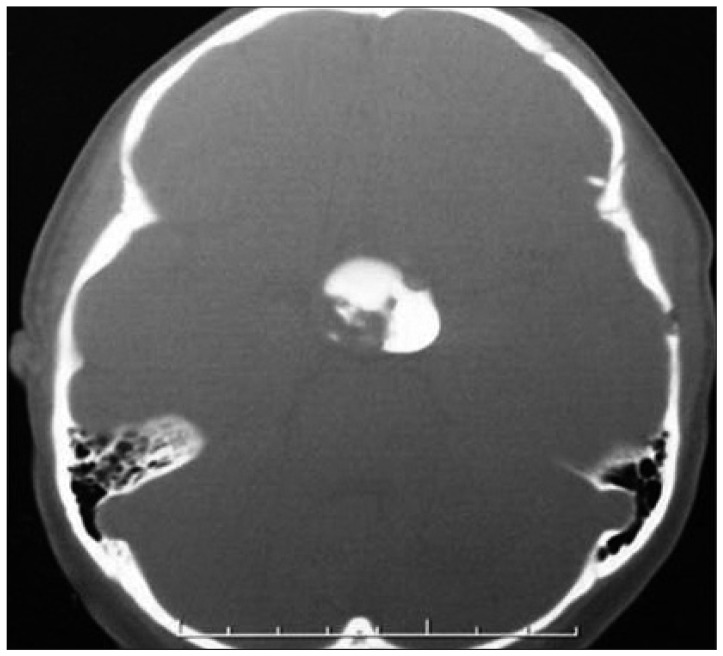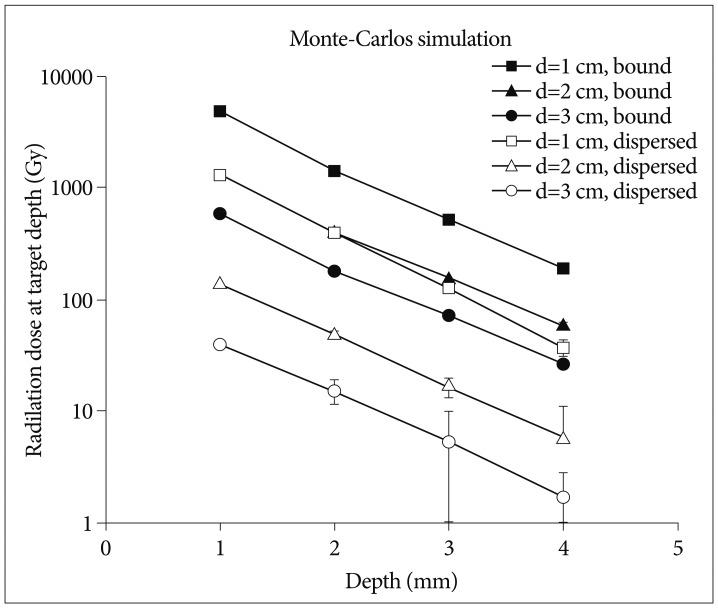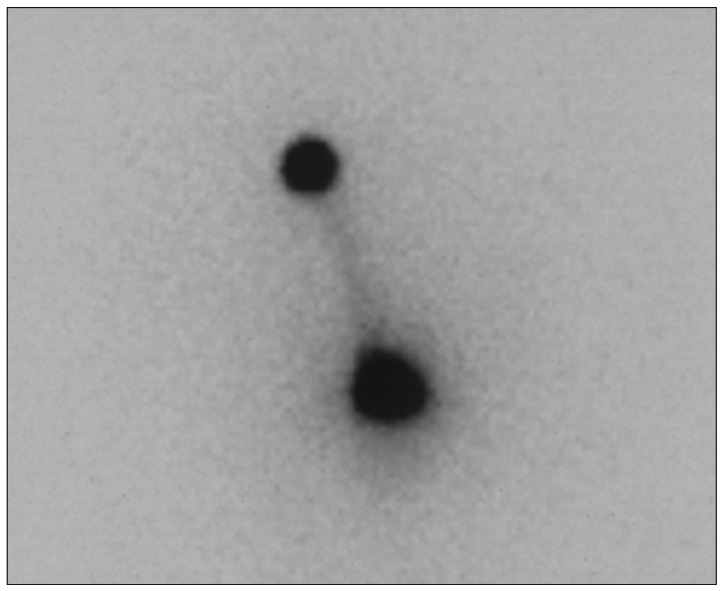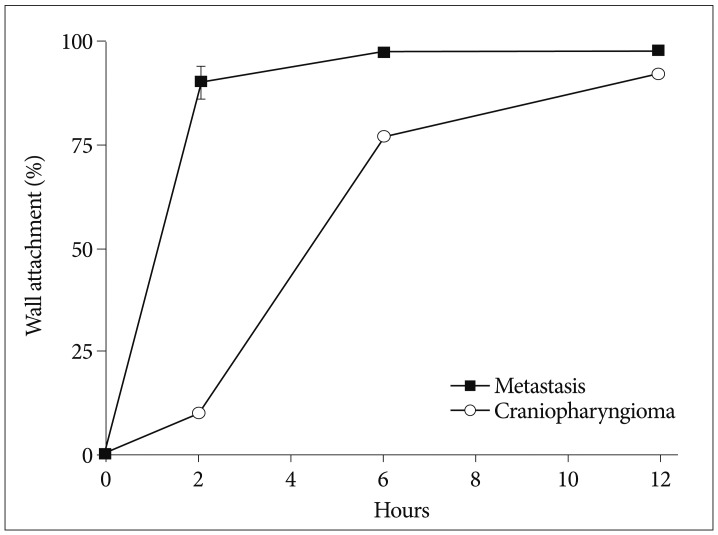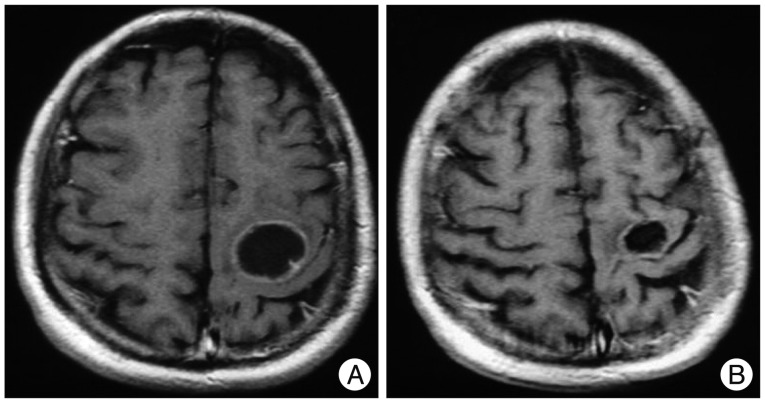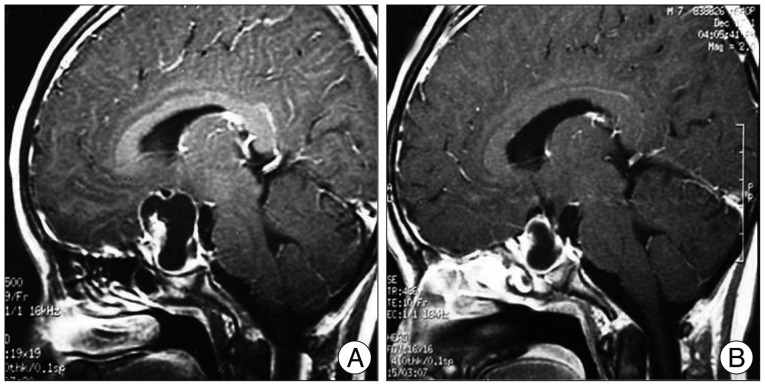J Korean Neurosurg Soc.
2013 Sep;54(3):175-182. 10.3340/jkns.2013.54.3.175.
Intracavitary Radiation Therapy for Recurrent Cystic Brain Tumors with Holmium-166-Chico : A Pilot Study
- Affiliations
-
- 1Neuro-Oncology Clinic, National Cancer Center, Ilsan, Korea. nsghs@ncc.re.kr
- 2Department of Neurosurgery, Nuclear Medicine, Seoul, Korea.
- 3Department of Neurosurgery, Korea Institute of Radiological and Medical Science, Seoul, Korea.
- 4Department of Nuclear Medicine, Seoul National University Hospital, Seoul, Korea.
- KMID: 2190894
- DOI: http://doi.org/10.3340/jkns.2013.54.3.175
Abstract
OBJECTIVE
Intracavitary injection of beta-emitting radiation source for control of cystic tumors has been tried with a benefit of localized internal radiation. The authors treated cystic brain tumor patients with Holmium-166-chitosan complex (Ho-166-chico), composed of a beta-emitting radionuclide Holmium-166 and biodegradable chit polymer, and evaluated the safety and effective measurement for response.
METHODS
Twenty-two patients with recurrent cystic brain tumor and/or located in a deep or eloquent area were enrolled in this pilot study. The cyst volume and wall thickness were determined on CT or MRI to assess radiological response. The activity of Ho-166-chico injected via Ommaya reservoir was prescribed to be 10-25 Gy to the cyst wall in a depth of 4 mm.
RESULTS
There was neither complications related to systemic absorption nor leakage of Ho-166-chico in all 22 patients. But, two cases of oculomotor paresis were observed in patients with recurrent craniopharyngioma. Radiological response was seen in 14 of 20 available follow-up images (70%). Seven patients of 'evident' radiological response experienced more than 25% decrease of both cyst volume and wall thickness. Another 7 patients with 'suggestive' response showed decrease of cyst volume without definitive change of the wall thickness or vice versa. All patients with benign tumors or low grade gliomas experienced symptomatic improvement.
CONCLUSION
Ho-166-chico intracavitary radiation therapy for cystic tumor is a safe method of palliation without serious complications. The determination of both minimal effective dosage and time interval of repeated injection through phase 1 trial could improve the results in the future.
Keyword
MeSH Terms
Figure
Reference
-
1. Backlund EO, Johansson L, Sarby B. Studies on craniopharyngiomas. II. Treatment by stereotaxis and radiosurgery. Acta Chir Scand. 1972; 138:749–759. PMID: 4565719.2. Burton MA, Gray BN, Klemp PF, Kelleher DK, Hardy N. Selective internal radiation therapy : distribution of radiation in the liver. Eur J Cancer Clin Oncol. 1989; 25:1487–1491. PMID: 2591440.
Article3. Fox JL. Intermittent drainage of intracranial cyst via the subcutaneous Ommaya reservoir. Technical note. J Neurosurg. 1967; 27:272–273. PMID: 6047999.
Article4. Gutin PH, Klemme WM, Lagger RL, MacKay AR, Pitts LH, Hosobuchi Y. Management of the unresectable cystic craniopharyngioma by aspiration through an Ommaya reservoir drainage system. J Neurosurg. 1980; 52:36–40. PMID: 7350278.
Article5. Henson JW, Ulmer S, Harris GJ. Brain tumor imaging in clinical trials. AJNR Am J Neuroradiol. 2008; 29:419–424. PMID: 18272557.
Article6. Huk WJ, Mahlstedt J. Intracystic radiotherapy (90Y) of craniopharyngiomas : CT-guided stereotaxic implantation of indwelling drainage system. AJNR Am J Neuroradiol. 1983; 4:803–806. PMID: 6410858.7. Julow J, Lányi F, Hajda M, Simkovics M, Arany I, Tóth S, et al. The radiotherapy of cystic craniopharyngioma with intracystic installation of 90Y silicate colloid. Acta Neurochir (Wien). 1985; 74:94–99. PMID: 3984798.
Article8. Kim JH, Lee JT, Kim EK, Won JY, Kim MJ, Lee JD, et al. Percutaneous sclerotherapy of renal cysts with a beta-emitting radionuclide, holmium-166-chitosan complex. Korean J Radiol. 2004; 5:128–133. PMID: 15235238.
Article9. Kobayashi T, Kageyama N, Ohara K. Internal irradiation for cystic craniopharyngioma. J Neurosurg. 1981; 55:896–903. PMID: 6271932.
Article10. Lange M, Kirsch CM, Steude U, Oeckler R. Intracavitary treatment of intrasellar cystic craniopharyngeomas with 90-Yttrium by trans-sphenoidal approach--a technical note. Acta Neurochir (Wien). 1995; 135:206–209. PMID: 8748817.11. Lee JD, Park KK, Lee MG, Kim EH, Rhim KJ, Lee JT, et al. Radionuclide therapy of skin cancers and Bowen's disease using a specially designed skin patch. J Nucl Med. 1997; 38:697–702. PMID: 9170430.12. Leksell L, Backlund EO, Johansson L. Treatment of craniopharyngiomas. Acta Chir Scand. 1967; 133:345–350. PMID: 4861250.13. Leksell L, Liden K. A therapeutic trial with radioactive isotopes in cystic brain tumor. Atomic Energy Research Establishment. Radioisotope Techniques : Medical and physiological applications. London: H.M. Stationery Office;1951. Vol 1.14. Liu Z, Tian Z, Yu X, Li S, Huang H, Kang G, et al. Stereotactic intratumour irradiation with nuclide for craniopharyngiomas. Chin Med J (Engl). 1996; 109:219–222. PMID: 8758313.15. Mumper RJ, Ryo UY, Jay M. Neutron-activated holmium-166-poly (L-lactic acid) microspheres : a potential agent for the internal radiation therapy of hepatic tumors. J Nucl Med. 1991; 32:2139–2143. PMID: 1941151.16. Muzzarelli R, Baldassarre V, Conti F, Ferrara P, Biagini G, Gazzanelli G, et al. Biological activity of chitosan : ultrastructural study. Biomaterials. 1988; 9:247–252. PMID: 3408796.
Article17. Nijsen JF, Zonnenberg BA, Woittiez JR, Rook DW, Swildens-van Woudenberg IA, van Rijk PP, et al. Holmium-166 poly lactic acid microspheres applicable for intra-arterial radionuclide therapy of hepatic malignancies : effects of preparation and neutron activation techniques. Eur J Nucl Med. 1999; 26:699–704. PMID: 10398817.
Article18. Park KB, Kim YM, Shin BC, Kim JR. Study on the preparations of new 166Ho-chitosan complex and its macroaggregates for a potential use of internal radiotherapy. Korean J Nucl Med. 1996; 30:351–360.19. Pollack IF, Lunsford LD, Slamovits TL, Gumerman LW, Levine G, Robinson AG. Stereotaxic intracavitary irradiation for cystic craniopharyngiomas. J Neurosurg. 1988; 68:227–233. PMID: 3276836.
Article20. Prestwich WV, Nunes J, Kwok CS. Beta dose point kernels for radionuclides of potential use in radioimmunotherapy. J Nucl Med. 1989; 30:1036–1046. PMID: 2738686.21. Rogers LR, Barnett G. Percutaneous aspiration of brain tumor cysts via the Ommaya reservoir system. Neurology. 1991; 41(Pt 1):279–282. PMID: 1992376.
Article22. Strauss L, Sturm V, Georgi P, Schlegel W, Ostertag H, Clorius JH, et al. Radioisotope therapy of cystic craniopharyngomas. Int J Radiat Oncol Biol Phys. 1982; 8:1581–1585. PMID: 7141933.23. Sturm V RT, Strauss L. Preliminary results of intracavitary irradiation of cystic craniopharyngiomas by means of stereotactically applied yittrium-90. In : Schiefer W KM, Brock M, editors. Advances in Neurosurgery. Berlin: Springer-Verlag;1981. Vol 9:p. 401–404.24. Suzuki YS, Momose Y, Higashi N, Shigematsu A, Park KB, Kim YM, et al. Biodistribution and kinetics of holmium-166-chitosan complex (DW-166HC) in rats and mice. J Nucl Med. 1998; 39:2161–2166. PMID: 9867162.25. Taasan V, Shapiro B, Taren JA, Beierwaltes WH, McKeever P, Wahl RL, et al. Phosphorus-32 therapy of cystic Grade IV astrocytomas : technique and preliminary application. J Nucl Med. 1985; 26:1335–1338. PMID: 2997419.
- Full Text Links
- Actions
-
Cited
- CITED
-
- Close
- Share
- Similar articles
-
- Intracavitary 166 Holmium - chitosan Complex Therapy in Patients with Malignant Peritoneal or Pleural Effusions
- Preclinical Trial of Radiation Synovectomy with Ho-166
- Feasibility of Endovascular Radiation Therapy Using Holmium-166 Filled Balloon Catheter in a Swine Hemodialysis Fistula Model: Preliminary Results
- Intracavitary Irradiation of Locally Advanced Recurrent Adenocarcinoma of Rectum Along the Fistula tract
- Percutaneous Sclerotherapy of Renal Cysts with a Beta-Emitting Radionuclide, Holmium-166-chitosan Complex

